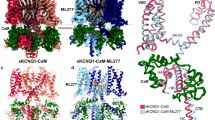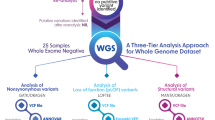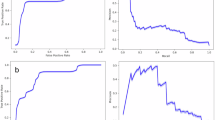Abstract
Long QT syndrome (LQTS) is a rare inherited arrhythmia disease characterized by a prolonged QT interval on 12-lead electrocardiograms. It is the crucial factor to induce syncope, ventricular fibrillation, and even sudden cardiac death. Previous studies have proved that mutations of ion channels-related genes play an important role in LQTS patients. In this study, we enrolled a Chinese family with LQTS and syncope. With the help of whole-exome sequencing, we identified a novel nonsense mutation (c.439C>T/p.Q147X) of Ring Finger Protein 207 (RNF207) in this family. The novel mutation, resulting in a premature stop codon in exon 4 of the RNF207 gene, co-segregated with the affected individuals. Bioinformatics analysis and real-time PCR further proved that the newly identified mutation might induce nonsense-mediated mRNA decay. In mutation carriers, the level of RNF207 mRNA expression was much lower than controls, which may affect potassium channel KCNH2 and lead to LQTS and syncope. In this research, we reported a rare novel mutation of RNF207 in LQTS and syncope patients which further supports the significant role of RNF207 in potassium channel activation and expanded the spectrum of RNF207 mutations. These data may contribute to the genetic diagnosis and counseling of families with LQTS and syncope.
Similar content being viewed by others
Log in or create a free account to read this content
Gain free access to this article, as well as selected content from this journal and more on nature.com
or
References
Abrams DJ, Macrae CA. Long QT syndrome. Circulation. 2014;129:1524–9.
Bohnen MS, Peng G, Robey SH, Terrenoire C, Iyer V, Sampson KJ, et al. Molecular pathophysiology of congenital Long QT syndrome. Physiol Rev. 2017;97:89–134.
Giudicessi JR, Wilde AAM & Ackerman MJ. The genetic architecture of long QT syndrome: a critical reappraisal. Trends Cardiovasc Med. 2018,28: 453–64.
Nakano Y, Shimizu W. Genetics of Long-QT syndrome. J Hum Genet. 2016;61:51–5.
Okawa ER, Gotoh T, Manne J, Igarashi J, Fujita T, Silverman KA, et al. Expression and sequence analysis of candidates for the 1p36.31 tumor suppressor gene deleted in neuroblastomas. Oncogene. 2008;27:803–10.
Roder K, Werdich AA, Li W, Liu M, Kim TY, Organ-Darling LE, et al. RING finger protein RNF207, a novel regulator of cardiac excitation. J Biol Chem. 2014;289:33730–40.
Curran ME, Splawski I, Timothy KW, Vincent GM, Green ED, Keating MT. A molecular basis for cardiac arrhythmia: HERG mutations cause Long QT syndrome. Cell. 1995;80:795–803.
Han QY, Wang HX, Liu XH, Guo CX, Hua Q, Yu XH, et al. Circulating E3 ligases are novel and sensitive biomarkers for diagnosis of acute myocardial infarction. Clin Sci. 2015;128:751–60.
Mizushima W, Takahashi H, Watanabe M, Kinugawa S, Matsushima S, Takada S, et al. The novel heart-specific RING finger protein 207 is involved in energy metabolism in cardiomyocytes. J Mol Cell Cardiol. 2016;100:43–53.
Priest JR, Ceresnak SR, Dewey FE, Malloy-Walton LE, Dunn K, Grove ME, et al. Molecular diagnosis of long QT syndrome at 10 days of life by rapid whole genome sequencing. Heart Rhythm. 2014;11:1707–13.
Fan LL, Huang H, Jin JY, Li JJ, Chen YQ, Zhao SP et al. Whole exome sequencing identifies a novel mutation (c.333+2T>C) of TNNI3K in a Chinese family with dilated cardiomyopathy and cardiac conduction disease. Gene. 2018;648:63–7.
Huang H, Chen YQ, Fan LL, Guo S, Li JJ, Jin JY, et al. Whole-exome sequencing identifies a novel mutation of GPD1L (R189X) associated with familial conduction disease and sudden death. J Cell Mol Med. 2018;22:1350–4.
Baker KE, Parker R. Nonsense-mediated mRNA decay: terminating erroneous gene expression. Curr Opin Cell Biol. 2004;16:293–9.
Kurosaki T, Maquat LE. Nonsense-mediated mRNA decay in humans at a glance. J Cell Sci. 2016;129:461–7.
Consortium GT. The Genotype-Tissue Expression (GTEx) project. Nat Genet. 2013;45:580–5.
Newton-Cheh C, Eijgelsheim M, Rice KM, de Bakker PI, Yin X, Estrada K, et al. Common variants at ten loci influence QT interval duration in the QTGEN Study. Nat Genet. 2009;41:399–406.
Pfeufer A, Sanna S, Arking DE, Muller M, Gateva V, Fuchsberger C, et al. Common variants at ten loci modulate the QT interval duration in the QTSCD Study. Nat Genet. 2009;41:407–14.
Noseworthy PA, Havulinna AS, Porthan K, Lahtinen AM, Jula A, Karhunen PJ, et al. Common genetic variants, QT interval, and sudden cardiac death in a Finnish population-based study. Circ Cardiovasc Genet. 2011;4:305–11.
Walker VE, Atanasiu R, Lam H, Shrier A. Co-chaperone FKBP38 promotes HERG trafficking. J Biol Chem. 2007;282:23509–16.
Walker VE, Wong MJ, Atanasiu R, Hantouche C, Young JC, Shrier A. Hsp40 chaperones promote degradation of the HERG potassium channel. J Biol Chem. 2010;285:3319–29.
Badciong JC, Haas AL. MdmX is a RING finger ubiquitin ligase capable of synergistically enhancing Mdm2 ubiquitination. J Biol Chem. 2002;277:49668–75.
Ficker E, Dennis AT, Wang L, Brown AM. Role of the cytosolic chaperones Hsp70 and Hsp90 in maturation of the cardiac potassium channel HERG. Circ Res. 2003;92:e87–100.
Acknowledgements
We thank all subjects for participating in this study. This study was supported by the National Natural Science Foundation of China (81370394 and 81500359).
Author information
Authors and Affiliations
Corresponding author
Ethics declarations
Conflict of interest
The authors declare that they have no conflict of interest.
Electronic supplementary material
Rights and permissions
About this article
Cite this article
Fan, LL., Chen, YQ., Huang, H. et al. Exome sequencing identifies a novel nonsense mutation of Ring Finger Protein 207 in a Chinese family with Long QT syndrome and syncope. J Hum Genet 64, 233–238 (2019). https://doi.org/10.1038/s10038-018-0549-1
Received:
Revised:
Accepted:
Published:
Issue date:
DOI: https://doi.org/10.1038/s10038-018-0549-1



